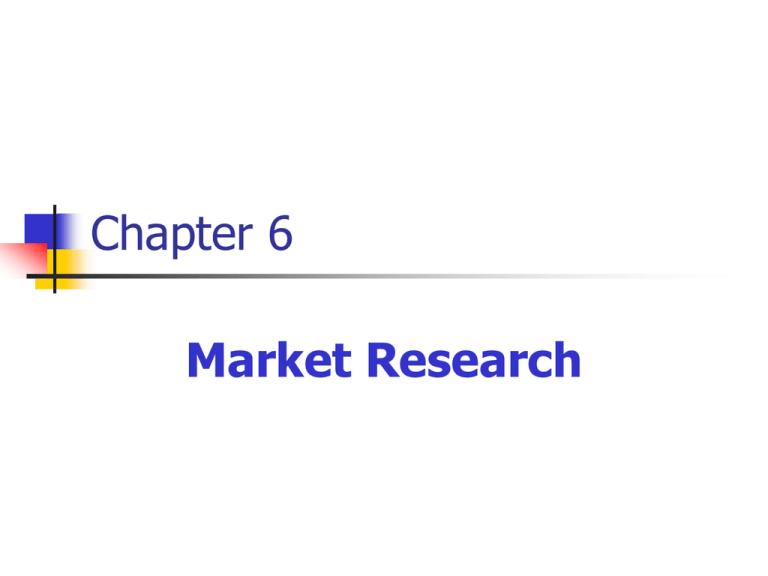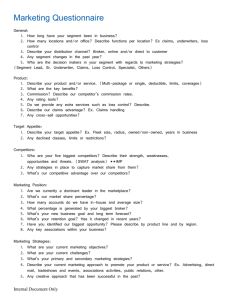Chapter 6 Market Research
advertisement

Chapter 6 Market Research Market Research Markets for products and services are found within and across industries. An industry- is a collection of businesses with a common line of products. It includes manufacturers, suppliers, distributors, and anyone else who is involved within the industry. Market Research Industries There are four factors that are useful to understanding the nature of an industry. Market Research Industries 1. 2. Carrying Capacity- is a way to understand the industry’s ability to support new growth. Uncertainty- is the degree of stability or instability in an industry. An industry that is fast-changing has a high degree of uncertainty and therefore more risk. Market Research Industries 3. Complexity- is the number and diversity of contacts with which you must deal. Firms that operate in a complex environment, usually have more suppliers, customers, and competitors than firms in other industries. They are also more global in nature. Market Research Industries 4. Stage of Life Cycle- these stages include: 1. Birth 2. Growth 3. Maturity 4. Decline. If you know what stage the industry is in, you can design a business strategy to be compatible with it. Target Market and Customer A market- is a group of people or companies who have a demand for a product or service and are willing and able to buy it. Industrial Markets- are those customers who buy goods or services for business use. Industrial goods are goods or components produced for sale to manufacturers and used in the production of other goods. A Target Market –is a particular group of people you are interested in. Target Market and Customer Market Segmentation- is the process of grouping a market into smaller subgroups defined by specific characteristics. Market Segments- are subgroups of buyers with similar characteristics. Once they are identified, a business can customize its products to meet the needs of the segment. Target Market and Customer There are four ways to segment a market: 1. Geographics- is based on where the people live. 2. Demographics- are the personal characteristics of the population such as religion, race, income, and occupation. Target Market and Customer 3. Psychographics- is the study of consumers based on social and psychological characteristics. These include personality, values, opinions, beliefs, and attitudes. 4. Buying Characteristics- are knowledge of and personal experiences with the actual goods. Target Market and Customer Four characteristics of a target market segment. 1. The market segment should be measurable. 2. The segment should be large enough to be profitable. 3. The segment should be reachable. 4. The market segment should be responsive. Market Research Market ResearchIs the collection and analysis of information aimed at understanding the behavior of consumers in a certain market. The marketing research process can be used to identify potential markets, analyze demand, forecast sales, and make other decisions. Market Research Identifying the focus of the research is important so you do not waste time gathering useless information. Select the type of research you want to do. These types of market researches are called research designs. Market Research 1. 2. Exploratory research- is used when very little is known about the subject. Focus group- is a group of people whose opinions are studied to determine the opinions expected from the larger population. Market Research 3. Descriptive research- is done when you want to determine the status of something. You may want to develop a customer profile. To do so, you need to learn the age, gender, occupation, income, and buying habits of potential customers. Market Research 4. Historical research- involves studying the past. Patterns from the past can then be used to explain present trends. Starting Market Research The following are the steps used in starting the research process. Starting Market Research 1. Identify your information needsbefore you begin to collect data on your market, you should identify the kinds of information you need. How will the data be used? What data needs to be collected? What methods of analysis will be used? Starting Market Research 2. Obtain secondary resourcesInformation that has already been collected by someone else. It is easily obtained and is inexpensive. A good place to start is the internet. What are the demographics of the customer? Starting Market Research What are the pyschographics of the customer? How large is the market? Is the market growing? Is the market affected by geography? How can you reach your market? How do your competitors reach the market? What market strategies have been successful with these customers? Starting Market Research 3. Collect primary dataThis is the data you obtain for the first time and use specifically for your study. What are the demographics of your customers? Would potential customers purchase your product or service? Why or why not? Starting Market Research How much would customers purchase? How would customers like to find the product or service? What do customers like about your competitors’ products or services. Starting Market Research 4. Organize the dataCategorize data based on the research question it answers. Working on each question, note how many of your sources supported a particular conclusion and how many did not. Then create charts and graphs to depict your findings. Starting Market Research 5. Analyze the DataNow that your information has been organized, ask yourself these questions to help you judge your chances of having a successful business: Is there a market for the product or service? Starting Market Research How big is the market? Will the industry support such a business? What do substitute products/services reveal about demand for the product/service? What do customers, end users, and intermediaries predict the demand will be?





